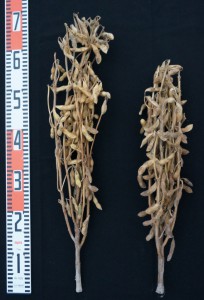
A photo provided by Western Region Agricultural Research Center shows Koganesayaka (left), a new variety suited for production of tofu, soy milk and soy sauce, and Sachiyutaka, a soybean cultivar widely grown in southwestern Japan.
National Agriculture and Food Research Organization’s Western Region Agricultural Research Center has developed Koganesayaka, a new soybean variety suitable for production of tofu bean curd and soy milk.
Koganesayaka’s period of maturity is about the same as Sachiyutaka, a high-yield variety widely grown in southwestern Japan for use in processing, with 10 percent more yield than Sachiyutaka. The new variety is expected to be cultivated in Tatsuno, Hyogo Prefecture, starting next year.
The center cultivated Koganesayaka in Zentsuji, Kagawa Prefecture, between 2009 and 2013, and harvested 431 kg per 10 ares, 10 percent more than Sachiyutaka. Its seed size is medium, the same size as Tamahomare, another variety used for production of tofu and soy milk. Koganesayaka is suitable for cultivation in temperate regions. It has low incidence of straighthead and is resistant to peanut stunt virus.
-300x143.jpg) The variety does not contain lipoxygenase, an isozyme which causes grassy soy odor, so it is regarded as suited to producing tofu and soy milk. Soybean seeds usually contain three different kinds of lipoxygenase, but Koganesayaka is developed by crossbreeding L-star and Sachiyutaka, both of which do not contain any of the isozymes.
The variety does not contain lipoxygenase, an isozyme which causes grassy soy odor, so it is regarded as suited to producing tofu and soy milk. Soybean seeds usually contain three different kinds of lipoxygenase, but Koganesayaka is developed by crossbreeding L-star and Sachiyutaka, both of which do not contain any of the isozymes.
Cultivation of Koganeyutaka will start in Tatsuno, Hyogo Prefecture and neighboring districts, replacing Tamahomare, to be used to produce soy sauce. Researchers believe Koganeyutaka is suited also for production of soy sauce, as it contains more protein – a source of flavor of soy sauce – than Tamahomare. The center hopes it will also be used as an ingredient for light-colored soybean paste.
(Dec. 18, 2014)

